Khajuraho temple
Khajuraho Mandir
The Khajuraho Temples in Madhya Pradesh, India, are a group of Hindu and Jain temples famous for their intricate carvings and sculptures. Built between the 9th and 12th centuries, these temples showcase a unique blend of architectural styles. Though some carvings depict sensual scenes, the majority portray aspects of daily life, mythology, and religious stories. Today, the Khajuraho Temples are a UNESCO World Heritage Site and a major tourist attraction.
History of the Temple

The story of Khajuraho starts in the times of Chandela Dynasty, a powerful kingdom that ruled the Bundelkhand region. While the area likely had earlier temples, the Chandelas were prolific builders, leaving behind a legacy of beautiful architecture. During their reign, Khajuraho flourished as a major cultural and religious center, attracting skilled artisans and scholars.
The exact reasons for the construction of such a vast temple complex remain unclear. However, historians believe the Chandela kings were devout Hindus and Jains, and the temples served as expressions of their faith. They might have also been built to commemorate victories or as a way to project royal power and prestige.
The construction of the temples spanned several centuries. The earliest known structures, such as the Lalguan Mahadeva Temple and the Brahma Temple, date back to the 9th century. Some of the most renowned temples, including the Kandariya Mahadeva and the Vishwanatha Temple, were built during the 10th and 11th centuries. By the 12th century, the construction activity had slowed down, possibly due to the decline of the Chandela Dynasty.
The Khajuraho temples are not only remarkable for their historical significance but also for their captivating architectural style. They belong to the Nagara style of North Indian temple architecture, characterized by towering shikharas (spires), intricately carved pillars, and sculpted panels depicting various themes. The temples are built using sandstone, which has weathered beautifully over time, adding a unique charm to their appearance.
Sadly, after the decline of the Chandela Dynasty, Khajuraho faded into obscurity. The temples were gradually overtaken by the surrounding forests and remained largely unnoticed for centuries. It wasn't until the 18th century that a British captain rediscovered the complex, bringing it back to the attention of the world.
Today, Khajuraho stands as a testament to the artistic brilliance and religious fervor of the Chandela era. The intricate carvings on the temple walls depict a variety of themes, including scenes from Hindu stories, depictions of daily life, and some well-known for their sensuality. While these carvings have generated much discussion, they are believed to represent a celebration of life and fertility within the broader context of Hindu tradition.
Significance of the Temple
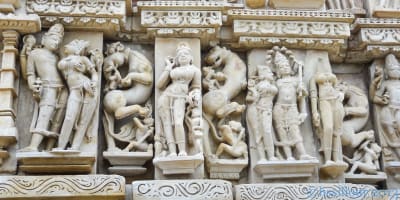
Their significance lies in a unique blend of historical, religious, and artistic value. The temples stand as a testament to the reign of the Chandela Dynasty (9th-12th centuries CE). These devout Hindu and Jain rulers constructed the temples not only as expressions of faith but also as a symbol of their power and prosperity. The vast scale of the complex, with over 85 temples built over centuries, reflects the Chandela Dynasty's cultural and religious influence during their peak.
Secondly, the architectural style of Khajuraho holds immense significance. The temples belong to the Nagara style, known for its towering shikharas (spires) that pierce the sky. The intricate carvings adorning the pillars, doorways, and walls showcase the exceptional craftsmanship of the era. These carvings depict various themes, including scenes from Hindu mythology like the Ramayana and Mahabharata, depictions of daily life like musicians and dancers, and some well-known for their sensuality. While the sensual carvings have sparked much debate, they are believed to represent a celebration of life and fertility within the framework of Hindu tradition.
The Khajuraho Temples hold religious significance for both Hindus and Jains. The complex houses temples dedicated to various Hindu deities like Shiva, Vishnu, and Devi, catering to a diverse range of worshippers. Similarly, Jain temples dedicated to figures like Mahavira and Parshvanatha reflect the importance of Jainism during the Chandela reign. The presence of both Hindu and Jain temples within the complex signifies a spirit of tolerance and respect for different religious beliefs that existed during that time.
Also, Khajuraho's rediscovery in the 18th century marked a significant turning point. After centuries of being hidden within the forests, the complex re-emerged as a window into India's rich past. This rediscovery sparked interest in Indian history and art, attracting scholars and tourists from around the world. Today, the temples are a UNESCO World Heritage Site, recognized for their outstanding universal value.
In conclusion, the significance of Khajuraho Temples goes beyond their visual appeal. They stand as a historical landmark showcasing the Chandela Dynasty's power and cultural influence. Their architectural style and carvings offer a glimpse into the artistic mastery and religious beliefs of the era. Moreover, the presence of both Hindu and Jain temples reflects a spirit of religious tolerance. Finally, the rediscovery of Khajuraho has contributed to our understanding of India's rich history and continues to attract visitors seeking to delve into this captivating legacy.
Architecture of the Temple
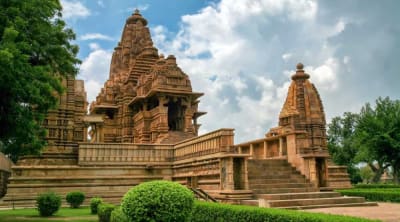
The architecture of Khajuraho Temple, located in Madhya Pradesh, India, is renowned for its exquisite beauty and intricate craftsmanship. Built between the 9th and 11th centuries by the Chandela dynasty, these temples showcase a blend of Hindu and Jain architectural styles. The temples are primarily divided into three groups: the Western Group, the Eastern Group, and the Southern Group.
The Western Group, comprising the most famous temples, is known for its stunning erotic sculptures depicting various aspects of human life, including love and intimacy, alongside religious motifs. The largest and most iconic temple in this group is the Kandariya Mahadeva Temple, dedicated to Lord Shiva. It stands as a marvel of architecture, with its intricately carved spires (shikharas) reaching heights of up to 31 meters. The walls of these temples are adorned with intricate carvings of deities, celestial beings, animals, and geometric patterns, showcasing the mastery of the artisans of that era.
The Eastern Group of temples, while less elaborate than the Western Group, still exhibits impressive architectural elements. The Parsvanath Temple, dedicated to Lord Parsvanath, is a notable highlight with its finely carved sculptures and detailed embellishments. The Adinath Temple, dedicated to Lord Shiva, also stands out for its elegance and artistic craftsmanship.
The Southern Group of temples, though smaller in scale, features unique architectural designs and intricate carvings. The Duladeo Temple, dedicated to Lord Shiva, is renowned for its finely sculpted images of deities and mythical creatures. The Chaturbhuj Temple, originally intended for Lord Vishnu but later consecrated to Lord Shiva, is another architectural gem with its imposing structure and elaborate carvings.
One of the striking features of Khajuraho Temple architecture is the use of sandstone, which lends a warm golden hue to the temples, especially during sunrise and sunset. The intricate carvings, depicting scenes from Hindu culture, daily life, celestial beings, and erotic motifs, highlight the skilled craftsmanship of the artisans of that era.
Timing
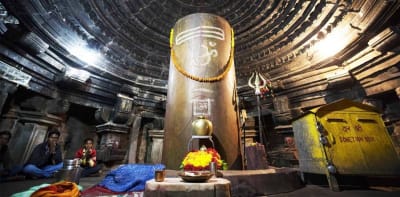
Khajuraho Temple is open to visitors from sunrise to sunset every day. The timings may vary slightly depending on the season.
- Morning opening time: 5:00 AM to 12:00 PM
- Evening opening time: 4:00 PM to 9:00 PM
Location

Located in the Chhatarpur district of Madhya Pradesh, India, Khajuraho Temple is nestled amidst serene surroundings and lush greenery. It's situated about 175 kilometers southeast of Jhansi and approximately 385 kilometers northeast of Bhopal.
Here is the Google maps link for the location - Click Here
How to Reach
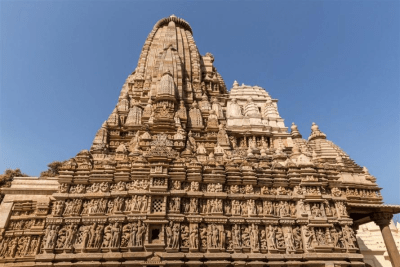
- By Air: The nearest airport to Khajuraho is the Khajuraho Airport, which is well-connected to major cities like Delhi, Mumbai, and Varanasi. From the airport, you can hire a taxi or take a bus to reach the temple complex.
- By Train: Khajuraho has its own railway station, and several trains connect it to major cities like Delhi, Mumbai, Agra, and Varanasi. Once you reach the railway station, you can hire a taxi or an auto-rickshaw to reach the temple.
- By Road: Khajuraho is well-connected by road to various cities in Madhya Pradesh and neighboring states. You can opt for state-run buses, private buses, or hire a taxi or cab for a comfortable journey.
Nearby Tourist Attractions
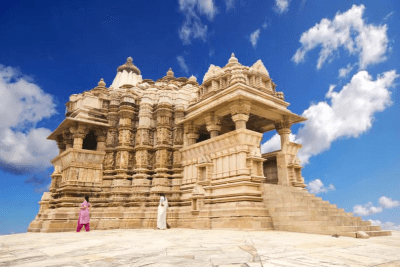
- Panna National Park: Located around 25 kilometers from Khajuraho, Panna National Park is a paradise for wildlife enthusiasts, offering opportunities to spot tigers, leopards, deer, and numerous bird species.
- Raneh Falls: Situated about 20 kilometers from Khajuraho, Raneh Falls is known for its picturesque waterfalls cascading through rocky terrain, offering a refreshing natural spectacle.
- Ken Gharial Sanctuary: This sanctuary, approximately 25 kilometers from Khajuraho, is home to the critically endangered gharial species of crocodiles, along with other wildlife like turtles, deer, and migratory birds.
- Chandela Cultural Complex: Explore the rich cultural heritage of Khajuraho at the Chandela Cultural Complex, where you can witness traditional dance performances, art exhibitions, and learn about the region's history and culture.
Must Plan your Next Trip
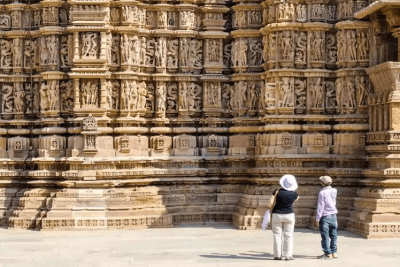
The Khajuraho Temples stand as a remarkable testament to a bygone era. Their captivating architecture, intricate carvings, and historical significance continue to enthrall visitors from across the globe. These temples offer a window into the artistic mastery, religious beliefs, and cultural influences of the Chandela Dynasty. Whether seeking a deeper understanding of Hinduism and Jainism, marveling at the architectural brilliance, or simply appreciating the beauty of art, the Khajuraho Temples offer a truly enriching experience. So, a visit to Khajuraho is not just a journey through stone and carvings; it's a captivating exploration of India's rich heritage.




